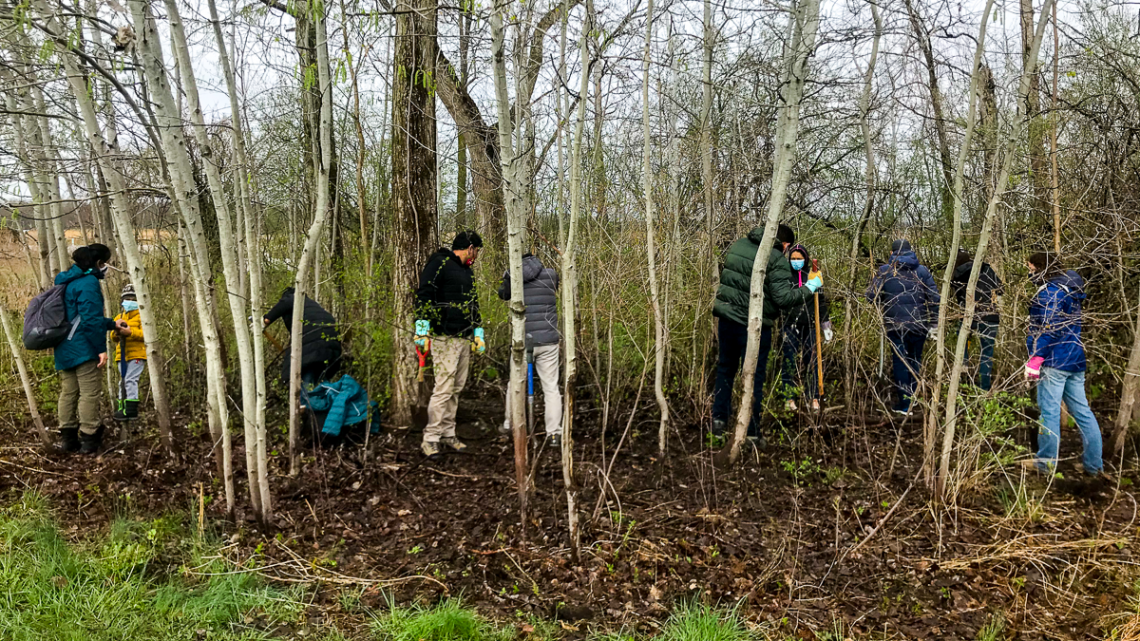
Hubert H. Humphrey Fellows from Cornell remove invasive buckthorn from the Montezuma National Wildlife Refuge on April 17.
News directly from Cornell's colleges and centers
Cornell Humphrey Fellows help conserve local wetland habitats
By Mofenyi Keddy Moleofi
Migratory birds are a welcome sight at the Montezuma National Wildlife Refuge, a nearly 10,000-acre refuge and breeding ground for birds and native wildlife. But there’s an unwelcome visitor establishing itself in the refuge in the heart of the Finger Lakes.
Common buckthorn, a non-native invasive plant from Europe and western Asia, is a major threat to ecosystems. The plant causes billions of dollars of economic impact across the U.S. each year. At the Montezuma National Wildlife Refuge, it is crowding out native species.
To help combat this invasive plant, Hubert H. Humphrey Fellows from Cornell volunteered for eradication efforts. A dozen Fellow volunteers took part in the efforts Saturday, April 17 as part of early Earth Day activities promoting the theme “Earth Restoration.”
The Hubert H. Humphrey Fellowship Program is Fulbright exchange activity through the U.S. Department of State. Cornell — one of 13 Humphrey Program campuses — provides accomplished professionals from countries with emerging economies a year of professional development with a focus on one of three, often overlapping, areas of interest: agriculture, environment, and natural resource management. The program is based in the Department of Global Development in the College of Agriculture and Life Sciences.
Before beginning their volunteer service the Fellows toured the education center where they were introduced to the history of the area and the mission and the goals of the wildlife refuge. First established in 1938, the refuge has been instrumental in successfully rehabilitating the Bald Eagle population in the area, which plunged and was near extinction due to the impacts of the insecticide DDT. Along with Bald Eagles, the habitat supports many migratory waterfowl species as well as endangered fishes.
Outside, the Fellows spent the morning using physical control methods to uproot the plant buckthorn and the use of spades. The work quickly showed how difficult it is to control invasive species, and these non-native plants can sometimes threaten native species with extinction.
After the invasive plant removal work was completed, the Fellows toured the refuge with a guide who explained wetland restoration in the area and efforts to maintain suitable habitat for wetland species. The Fellows viewed control station operations that are used to regulate the water level for the wetlands system to ensure as much as possible that these wetlands maintain natural habitat.
“Volunteer service is not only an excellent way to help a wildlife refuge like Montezuma, but also provides a bit of first-hand experience on local conservation challenges,” said Polly Endreny Holmberg, associate director for Cornell’s Humphrey Program.
The Humphrey Fellows learned much more about wetland restoration and management practices applied on a landscape level to benefit both wildlife and conservation. These are methods that could be applied in a Fellow’s home country or provide ideas on managing similar wetlands to restore their health and bring back wildlife in areas that are degraded or have lost the ability to support wildlife well.
This experience is especially relevant to climate change. Wetlands around the world are being affected by droughts and overuse of agricultural practices. Restoring and mimicking natural landscapes like wetlands provide bird, fish, and other wildlife with good habitat and maintaining buffer coastal communities against flooding provides suitable habitat for wading birds.
This article originally appeared in the CALS Newsroom.
Keddy Moleofi is a Cornell Hubert H. Humphrey Fellow.
Media Contact
Get Cornell news delivered right to your inbox.
Subscribe
